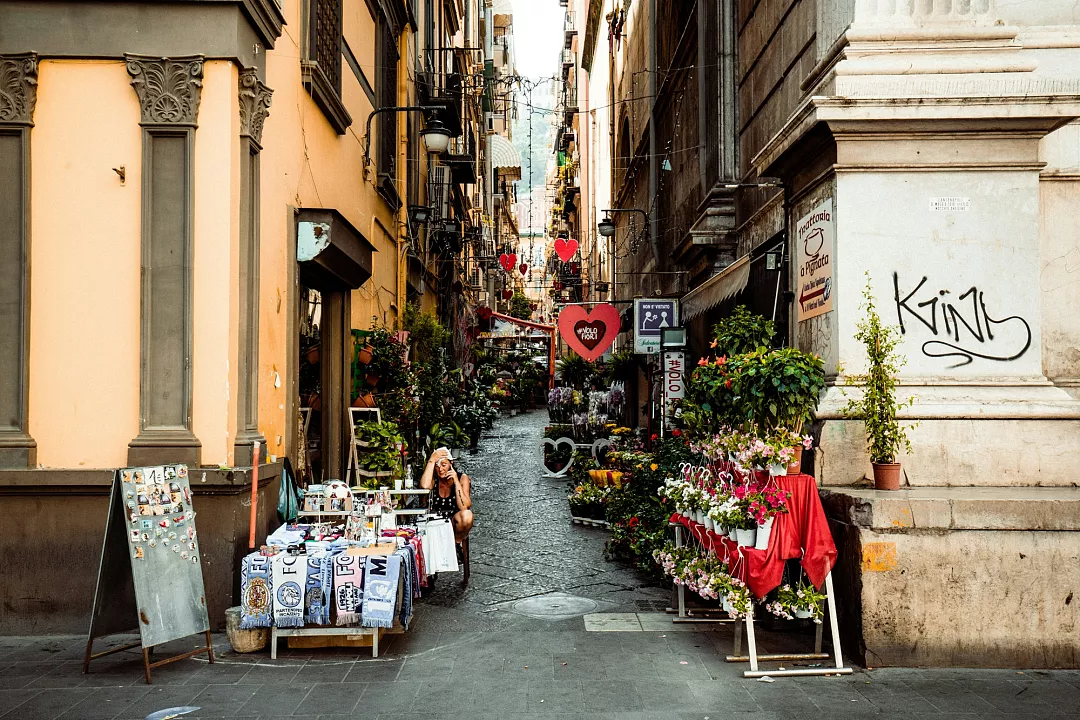Naples, a city steeped in a staggering 2,500 years of history, is currently experiencing an unprecedented tourism boom. This surge in visitors marks a significant turning point for a destination often overlooked or unfairly characterized in the past.
Yet, as Naples basks in its newfound global spotlight, it’s simultaneously grappling with the accelerated downsides that many other popular cities have encountered only after decades of sustained tourism growth. This unique confluence of celebration, economic opportunity, and growing urban challenges paints a vivid picture of a city undergoing rapid, profound metamorphosis.
Just a decade ago, guidebooks, hotel staff, and even concerned locals would issue stern warnings about navigating Naples, particularly for solo foreign women. The Quartieri Spagnoli, a vibrant but then-notorious neighborhood, was unequivocally off-limits due to widespread concerns about crime and violence. Fast forward to 2025, the very year of Naples’ 2,500th anniversary, and the city’s transformation is almost disorienting in its pace.
A recent taxi ride revealed the extent of this shift: when asked for dinner recommendations, the driver’s immediate suggestion was, remarkably, “anywhere in the Quartieri Spagnoli.” This dramatic change encapsulates a broader narrative unfolding across the city, bringing with it both undeniable benefits and increasingly urgent burdens that demand strategic attention.
Naples’ Enduring Legacy: 2,500 Years of History
The city’s current moment in the spotlight is not merely fleeting; it’s a long-deserved recognition of its profound historical and cultural significance.
A Living Palimpsest of Time
As Naples justly celebrates its 2,500th anniversary, it reveals itself as a true palimpsest of history. This term perfectly describes a city where layers upon layers of 25 centuries of human activity, culture, and architecture are visibly intertwined, creating a heady, alluring, and theatrical concoction that captivates every visitor.
The sheer depth of its past is astonishing. Within the tightly packed grid plan of the centro storico, the city’s historic center, history literally lies beneath your feet. For example, subterranean 2nd-century catacombs exist directly below the charming, shaded alleys. These alleys are themselves lined with decadent 16th-century palazzos, their grand facades whispering tales of bygone eras.
Further enhancing this rich tapestry, ancient heavy stone-carved churches often conceal treasures from different periods. These sacred spaces might house delicate 4th-century mosaics alongside dramatic 17th-century Caravaggio paintings, showcasing an incredible artistic and historical continuity that few other cities can match. Every corner turned in Naples is an encounter with a different epoch, making it a living museum that constantly invites exploration and discovery. This deep historical resonance is a fundamental draw for tourists seeking authenticity and a profound connection to the past.
Anniversary Celebrations and Cultural Enhancements
To commemorate its monumental 2,500th anniversary, Naples is hosting a variety of cultural events and opening new attractions throughout the year. The magnificent Teatro San Carlo, an 18th-century opera house lavishly gilded and considered one of the oldest working opera houses in the world, boasts a rich program of performances designed to entertain and educate. This offers visitors a chance to experience world-class arts within a stunning historical setting.
In addition to live performances, the city’s museum landscape is expanding. A significant development is the opening of a new section of the prestigious Archaeological Museum of Naples (MANN) in early June. MANN is renowned globally for its extensive collection of Roman artifacts from Pompeii and Herculaneum, and this expansion will undoubtedly enhance the visitor experience.
Later in the year, in November, the Museo di Capodimonte will inaugurate a new exhibition space dedicated to porcelain. This addition highlights Naples’ artistic heritage beyond classical antiquity, showcasing its historical role in crafts and decorative arts. These cultural investments further solidify Naples’ position as a major cultural destination, encouraging deeper engagement from tourists.
Italy’s ‘Wild Child’ Gets a Transformation
For decades, guidebooks and popular perception have persistently associated Naples with the adjective ‘gritty,’ often in a euphemistic nod to its persistent urban challenges.
Beyond the Gritty Stereotype: Authenticity and Urban Challenges
While it’s true that Naples delivers a raw, unfiltered authenticity in droves, a stark contrast to destinations like the Tuscan countryside, the Amalfi Coast, or Cinque Terre, which are sometimes seen as overly curated or even “spurious,” the term ‘gritty’ has also been a thinly veiled reference to Naples’ long-standing and very real problems. These issues historically included significant challenges with waste management and pervasive crime. For many years, these concerns deterred some tourists and shaped the city’s image negatively.
However, Naples is now actively and aggressively working to address these systemic problems. This commitment to urban improvement is a crucial step in transforming its reputation and enhancing the quality of life for both residents and visitors. Last year, the city council announced ambitious new strategies specifically aimed at keeping the streets clean. This proactive approach demonstrates a concerted effort to shed the ‘gritty’ label and present a more welcoming and aesthetically pleasing urban environment.
Initiatives for Cleanliness and Safety
The director of Naples’ waste management services, ASIA Napoli, publicly announced the “arrival of important news for the improvement of collection services.” These improvements are comprehensive and technologically driven. They include the launch of a new website to enhance transparency and public engagement, alongside the updating of communication services with citizens to foster greater participation in waste disposal efforts.
Crucially, ASIA Napoli is undertaking the “progressive installation of technological infrastructures for waste disposal and collection monitoring in the city.” This includes smart bins and sensors to optimize collection routes and efficiency, signifying a modern approach to a long-standing problem.
In addition to cleanliness, efforts to enhance public safety are yielding positive results. Crime rates are measurably decreasing, reflecting the impact of intensified efforts by law enforcement and community initiatives. Specifically, thefts were down 6 percent in 2024 compared to 2023, a tangible improvement.
Even more significantly, robberies saw a substantial decrease of 17.75 percent within the same period. These statistics highlight a concerted push towards making Naples a safer city, thereby improving the experience for both its residents and the growing number of tourists. This dual focus on cleanliness and safety is fundamentally reshaping the city’s image and enhancing its appeal as a global destination.
The Evolution of Naples’ Tourism Profile
Hand-in-hand with the city’s clean-up efforts is a notable shift in the type of tourism Naples is now attracting and actively welcoming.
Welcoming Luxury and Cruise Travelers
Naples is increasingly positioning itself as a destination for luxury travelers. While currently, the city hosts only a handful of five-star hotels (a stark contrast to Rome’s over 50 or Florence’s nearly identical number), several prominent big-chain luxury hotel openings are “in the pipeline.” These include confirmed projects from prestigious brands like Radisson, Roccoforte, and Marriott, signaling a significant expansion of high-end accommodation options. The presence of such renowned names indicates confidence in Naples’ burgeoning luxury tourism market.
The Romeo Hotel Napoli, a five-star establishment opened in 2008, appears to have accurately foreseen this emerging market. Its cutting-edge glass and steel structure, adorned with avant-garde artworks from the owner’s private collection, still maintains a very contemporary and “on trend” aesthetic. The hotel is proactively upgrading its amenities to cater specifically to this developing luxury market.
These enhancements include the addition of a vast Sisley Paris spa, a sophisticated cigar room, a stunning infinity pool with glass sides offering panoramic views, and a haute-cuisine Alain Ducasse-inspired restaurant. These improvements have proven immensely popular, drawing “many more international guests.” The hotel recently even hosted celebrated footballer Scott McTominay and his family during his championship final (and win) for Naples’ Serie A club, Napoli, further cementing its status as a premier destination.
Another relatively new and growing market for Naples is the cruise ship industry. In the summer months, the city’s port now sees an average of three liners docking daily, disgorging tens of thousands of tourists into its historic streets. Unlike more fragile destinations such as Venice or Santorini, Naples’ sheer size and robust infrastructure can more easily “digest” this massive influx of visitors.
This high volume of cruise passengers also translates into direct economic benefits. According to the taxi driver, cruise passengers represent a “big earner” for private transport companies, tour groups, and souvenir shops, injecting substantial revenue into the local economy.
Tourists Staying Longer and Exploring Deeper
Beyond the shifting demographics of visitors, there’s a significant change in how tourists are experiencing Naples. The city has witnessed a steady increase in tourist arrivals, with numbers up 15 percent from 2023 to 2024. More importantly, the visitors are becoming increasingly diverse.
As noted by Inès Sellami, owner of the art gallery-cum-guesthouse Atelier Inès, “A few years ago, it was mostly Italians, Germans, and maybe the occasional French couple. Now we get Americans, Brits, Koreans, Australians, even solo travelers from South America or India.” This broadened international appeal underscores Naples’ growing global reputation.
Crucially, visitors are also extending their stays and engaging more deeply with the city’s rich culture. Sellami observes, “People used to come for just one or two nights. Now they’re staying 4 or 5 nights, using Naples as a base but also diving deeper into the city itself.”
This shift from brief transit stops to extended stays indicates a growing desire for immersive cultural experiences. Guests are showing increased interest in local art, authentic cooking experiences, and the “stories behind things,” moving beyond simply “ticking off monuments.” This trend towards quality tourism suggests a more respectful and engaged visitor eager to uncover the true essence of Naples.
The Shadow Side of the Tourism Boom: Challenges and Concerns
While the tourism boom has undeniably brought numerous benefits to Naples, it has also rapidly accelerated several adverse effects that demand urgent attention from the city council.
Housing Crisis and Gentrification
One of the most pressing concerns fueled by rising visitor numbers is the explosive growth in the short-term rental market. This proliferation of Airbnb and similar platform-mediated rentals has, in turn, ignited a severe housing crisis, mirroring situations seen in other popular tourist destinations such as the Canary Islands and Barcelona.
A compelling study from 2023 highlighted that these short-term rentals are actively displacing low-income inhabitants from the historic center of Naples. This phenomenon, known as gentrification, forces long-term residents out of their traditional neighborhoods due to skyrocketing rental costs.
The statistics are alarming: the study revealed that Airbnb listings in Naples increased by a staggering 553 percent between 2015 and 2019 alone. Moreover, these listings are heavily concentrated in the neighborhoods suffering the highest economic hardship, exacerbating the struggles of vulnerable populations.
According to Tourism Review, the cost of renting an apartment in the historic center has effectively doubled in a decade, rising from between €550 and €600 ten years ago to a range of €1,200 to €1,400 today. This rapid escalation in housing costs is particularly worrying because, despite the increased job opportunities generated by tourism, wages are not seeing a substantial corresponding increase for many residents. Compounding this, Naples continues to grapple with one of the highest rates of youth unemployment in Italy, standing at 43 percent.
This creates a significant disparity where locals, especially young people, find it increasingly difficult to afford living in their own city, even as tourism-related jobs become available.
Overtourism and Cultural Preservation
Beyond housing, the sheer volume of visitors is beginning to strain the city’s infrastructure and cultural fabric. The “tunnel vision” view of Naples, often perpetuated by social media platforms like Instagram and TikTok, focuses heavily on a few iconic spots: Diego Maradona murals, traditional pizzerias, and the scenic waterside Lungomare for a spritz. This concentrated interest means that visitors disproportionately crowd the centro storico and Lungomare, leading to congestion, wear and tear on historical sites, and a diminished experience for both tourists and residents.
Sellami notes that “there are amazing neighborhoods that still don’t see many tourists,” suggesting an imbalance in visitor distribution. This highlights a classic symptom of overtourism, where popular areas become overwhelmed while equally rich but less-known parts of the city remain underexplored. Furthermore, the onus is partly on the tourists themselves.
Sellami observes that it’s “not unusual to find visitors who treat the city like a theme park, making loud noise at night and disrespecting churches or monuments.” This lack of cultural sensitivity is a common complaint across Europe’s overtourism hotspots, underscoring the need for greater awareness and education among visitors about respectful travel practices.
Charting a Course for Sustainable Tourism: Recommendations
To effectively manage the burgeoning tourism industry and mitigate its adverse effects, Naples requires a comprehensive and forward-thinking strategy.
Spreading the Wealth: Decentralizing Tourism
For Inès Sellami, a crucial strategy for easing the strain of overtourism is to spread visitors out more evenly across the city. This means actively encouraging them to explore beyond the heavily trafficked “usual spots.” Promoting lesser-known but equally captivating neighborhoods would alleviate pressure on the historic center and Lungomare, while also distributing economic benefits to a wider array of local businesses. This could involve developing new tourist itineraries, highlighting hidden gems, and working with local guides to craft unique experiences outside the traditional tourist circuit.
Enhancing Infrastructure and Communication
Practical improvements in urban infrastructure and communication are also vital. Sellami suggests that better transport connections within the city and clearer, more comprehensive signage, especially in English, would greatly assist tourists in navigating beyond the main attractions. Improved public transport links to outlying areas and readily available multilingual information can empower visitors to discover more of Naples independently and comfortably. This infrastructural support is essential for a more dispersed and sustainable tourism model.
Fostering Quality Over Quantity: Respectful Engagement
Ultimately, Sellami believes the focus should be on attracting “quality tourism”—people who come with curiosity and respect.” This philosophy prioritizes visitors who are genuinely interested in the culture, history, and people of Naples, rather than those who treat it merely as a backdrop for social media photos.
“If we welcome them properly and share the real Naples, everyone benefits,” she asserts. This involves proactive efforts to educate tourists about local customs, appropriate behavior in historical and religious sites, and the importance of supporting local, authentic businesses. This shift towards a more responsible and culturally aware visitor base can help mitigate the negative impacts of overtourism.
Despite the challenges, Sellami remains optimistic about the city’s future. “It’s been quite a transformation,” she reflects. “Now people are coming for Naples, they’re discovering the food, the art, the raw beauty of the city.” She acknowledges that “it’s still not a polished city,” but wisely concludes that “I think that’s part of the appeal.”
This sentiment captures the enduring charm of Naples: its authentic, unvarnished character is precisely what attracts many, even as it continues its journey of development and adaptation in the face of a new era of global prominence.








